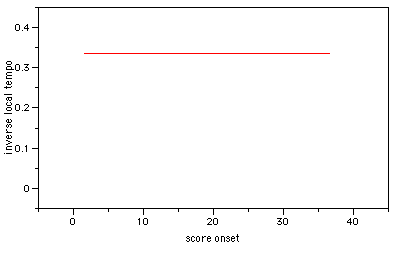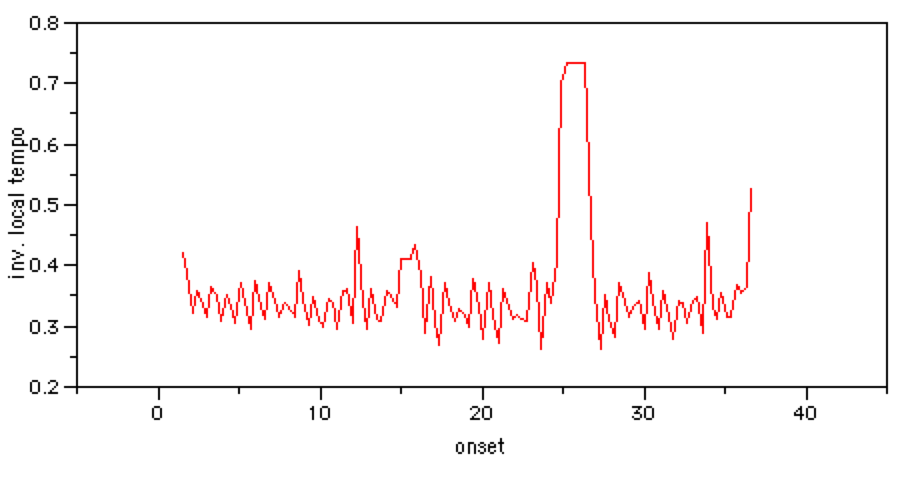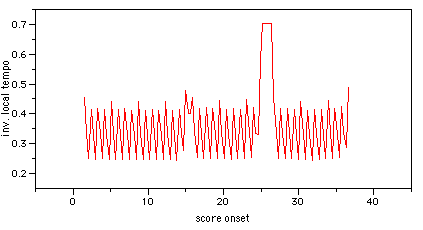De- and recomposition of expression in music performance - demo page
On this page a demonstration by means of soundfiles is given, as an
addition to section 3.3 of the final thesis of Michiel Borkent which
can be found in the link at the bottom of this page.
In short, the system can decompose expressive timing in a
performance, guided by a structural description of the music, into
timing profiles that correspond with the structural units in the music,
such as phrases, bars and ritards.
Using the results from the decomposition, the timing can be recomposed,
using a set of weights that control the contributions of the timing
profiles. For example, if one wants to filter out all the ritards but
wants to keep the other timing intact, the weight for the ritards is
set to 0, and the other weights to 1
.
To demonstrate some concrete results from this project, three performances were generated, using one original performance.
All of the above performances are characterized by their
expressive timing patterns, as it is called in scientific terms.
Expressive timing is the deviation a performer uses to in relation to
the structure of the music, like long phrases in the romantic
performance. Expressive timing can be seen as deviation from the global
tempo. A demonstration of a performance without deviation from the
global tempo can be heard hereunder.
Mechanical|
MP3
|
|
Renaissance alters the Classical pattern in the accompaniment, so
instead of short-long-short, it becomes long-short-short, somewhat more
characteristic of Renaissance dance music. In order to maintain
danceability, ritards are minimized.
|
|
Of the deviation of global tempo a diagram can be made. Because
in the previous example the performer does not deviate from global
tempo anywhere, the diagram is just a horizontal line. See Figure 1.
Figure 1: mechanical timing

|
In our system this corresponds with a recomposition with the timing
profiles all amplified with a weight 0. In other words, all expressive
timing is muted and only global tempo remains.
Table 1:
Recomposition - mechanical timing
| Structural unit |
weight |
| 48-phrase |
0 |
| 36-phrase |
0 |
| 12-phrase |
0 |
| 3-phrase |
0 |
| bar |
0 |
| leap |
0 |
| ritard |
0 |
| chord-ritard |
0 |
|
Conversely, a remix with all weights put to 1 corresponds with
the expressive timing just as in the original performance. See Table 2
and Figure 2.
Figure 2: reconstructed performance timing

|
Table 2:
Recomposition - original performance timing
| Structural unit |
weight |
| 48-phrase |
1 |
| 36-phrase |
1 |
| 12-phrase |
1 |
| 3-phrase |
1 |
| bar |
1 |
| leap |
1 |
| ritard |
1 |
| chord-ritard |
1 |
|
The weights and expressive timing diagram of ragtime are as follows. See Table 3 and Figure 3.
Figure 3: expressive timing diagram of ragtime

|
Table 3:
Recomposition - ragtime
| Structural unit |
weight |
| 48-phrase |
0.2 |
| 36-phrase |
0.2 |
| 12-phrase |
0 |
| 3-phrase |
2.5 |
| bar |
0.2 |
| leap |
0 |
| ritard |
1 |
| chord-ritard |
1 |
|
The expressive timing signal of romantic is given in Figure 4 and the corresponding weights in Table 4.
.
Figure 4: romantic expressive timing

|
Table 4:
Recomposition - Romantic
| Structural unit |
weight |
| 48-phrase |
0 |
| 36-phrase |
0 |
| 12-phrase |
3 |
| 3-phrase |
0 |
| bar |
0 |
| leap |
0 |
| ritard |
0 |
| chord-ritard |
0 |
|
The weights of Renaissance are given in Table 5 and the resulting expressive timing profile in Figure 5.
Figure 5: renaissance expressive timing

|
Table 5:
Recomposition - renaissance
| Structural unit |
weight |
| 48-phrase |
0 |
| 36-phrase |
0 |
| 12-phrase |
0 |
| 3-phrase |
-3.3 |
| bar |
0 |
| leap |
0 |
| ritard |
0 |
| chord-ritard |
0 |
|
Thanks go out to Ben Turner (a music psychology graduate from Ohio
State University) who tweaked and found out what configuration weigths
simulate the several styles.
More information about the work of the author of this page can be found at http://www.pictureofthemoon.net/~borkent/work
| 



